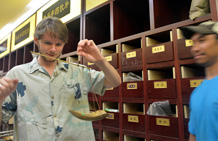
Interpretation of China’s cancer prevention and treatment three-year action plan (2015-2017)
Source: en.nhfpc.gov.cn
Updated: 2015-09-11
China’s National Health and Family Planning Commission, National Development and Reform Commission, and other government departments recently announced a 3-year cancer prevention and treatment plan for 2015-2017. Here is a description of that plan.
Background
Cancer is a serious threat to human health difficult that is difficult to treat and can shorten life expectancy, and can incur great cost and impoverish the victim. Cancer now claims many lives in China and has many causes, such as accelerated aging, environmental pollution, and unhealthy lifestyle, and has seen an increase in recent years. To date, 235 Chinese out of 100,000 have cancer, with 144 dying from it, or 23.5 percent. So, cancer has become one of the major public health problems in China.
Content
The plan was drawn up by experts to help with cancer prevention and control, stop the growth of cancer in China, protect and improve people's health, and cut the cost to society. In dealing with the urgent problems in cancer prevention and control over the next three years, it sets goals, basic methods, and support methods, as follows:
I. Goals: give priority to prevention, integrate prevention and treatment, combine traditional Chinese and western medicine, strengthen cancer prevention and controls, improve treatment and prevention strategies. There are six specific goals for 2017 in establishing prevention and control leaders and coordination, a cancer prevention and control network, standardized tumor registration, popularizing cancer prevention and treatments, and greater cancer screening and early detection and treatment. There needs to be steps taken to increase the five-year survival rate of major cancers. There need to be tumor registration on more than 30 percent of the population and cancer-related knowledge on 60 percent. Adult smoking needs to decrease by 3 percent, and the increase early diagnosis rate to 50 percent.
II. Basic methods: 1. Clarify responsibility of the National Health and Family Planning Commission, National Development and Reform Commission, and other government departments. 2. Improve the system and promote the national cancer center and the national cancer prevention and control network, improve regional cancer prevention and treatment, and improve staff training at the community level. 3. Increase tumor information collection and tumor registration and draw up a national cancer map. 4. Promote prevention and control of cancer risks, and increase smoking controls, immunization, environmental management and occupational protection. 5. Do early cancer screening, detection and treatment and reach more people, with better use of technology and study cancer prevention through examinations. 6. Improve diagnoses and treatment and cancer rehabilitation and palliative and hospice care. 7. Develop anti-tumor medicines, bring down costs through independent innovation and generic drugs, and increase access to medicines. 8. Try harder to apply traditional Chinese medicine to cancer prevention and control and to tumor clinical prevention and treatment. 9. Do more research and international cooperation, with the focus on environmental carcinogenic sources, early diagnosis and treatment of premalignant lesions, and early screening and detection. 10. Use science to increase public cancer awareness and traditional and new media to popularize a healthier way of life.
III. Support methods: 1. Everyone should improve their organization and leadership methods, establish national and provincial cancer prevention and treatment leadership coordination, and improve cancer prevention and controls under government leadership, interdepartmental cooperation, and society’s participation. 2. Morel should be spent on public health and healthcare security through financing channels and social capital. 3. Develop talented teams and specialized tumor and public health training, and improve prevention and control skills. 4. Improve supervision and inspections of all personnel and do performance evaluations with all departments clarifying their responsibilities and subject to performance evaluations.

World Family Summit
The World Family Organization was founded in Europe in 1947 and headquartered in Paris.
Link: / World Health Organization / United Nations Population Fund / UNICEF in China
Copyright 2014 National Health and Family Planning Commission of the PRC All rights reserved






